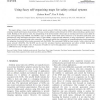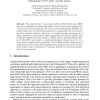7 search results - page 1 / 2 » Using Fuzzy Self-Organising Maps for Safety Critical Systems |
SAFECOMP
2004
Springer
13 years 10 months ago
2004
Springer
This paper defines a type of constrained artificial neural network (ANN) that enables analytical certification arguments whilst retaining valuable performance characteristics. ...
IDEAL
2004
Springer
13 years 10 months ago
2004
Springer
This paper defines a constrained Artificial Neural Network (ANN) that can be employed for highly-dependable roles in safety critical applications. The derived model is based upon t...
CBSE
2004
Springer
13 years 10 months ago
2004
Springer
Safety critical embedded real-time systems represent a class of systems that has attracted relatively little attention in research addressing component based software engineering. ...
ICECCS
1998
IEEE
13 years 9 months ago
1998
IEEE
The main focus of this paper is the problem of ensuring timeliness in safety critical systems. First, we introduce a method and its associated technique to model both real-time ta...
CISIS
2009
IEEE
13 years 11 months ago
2009
IEEE
The integration of heterogeneous data sources with even heterogeneous semantic meanings poses a challenge for data and system integrators. Ontology Alignment (OA) tries to identif...


